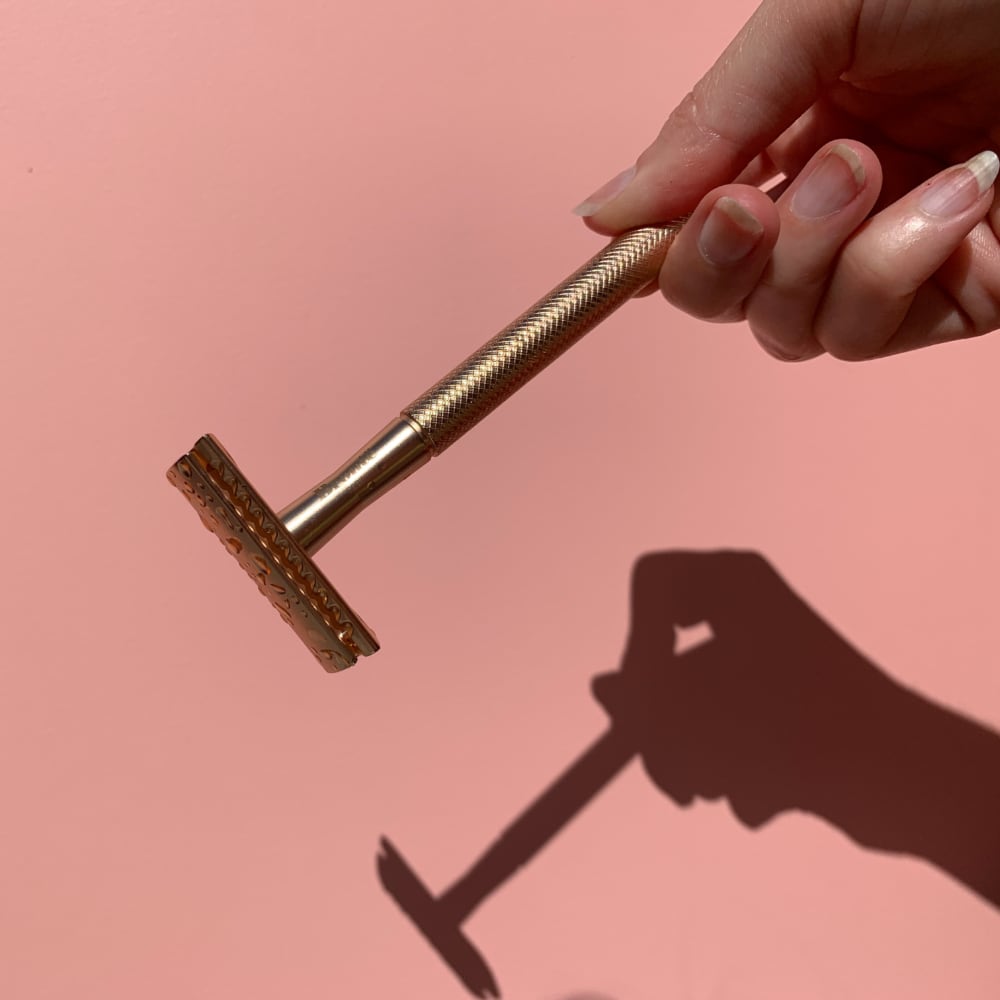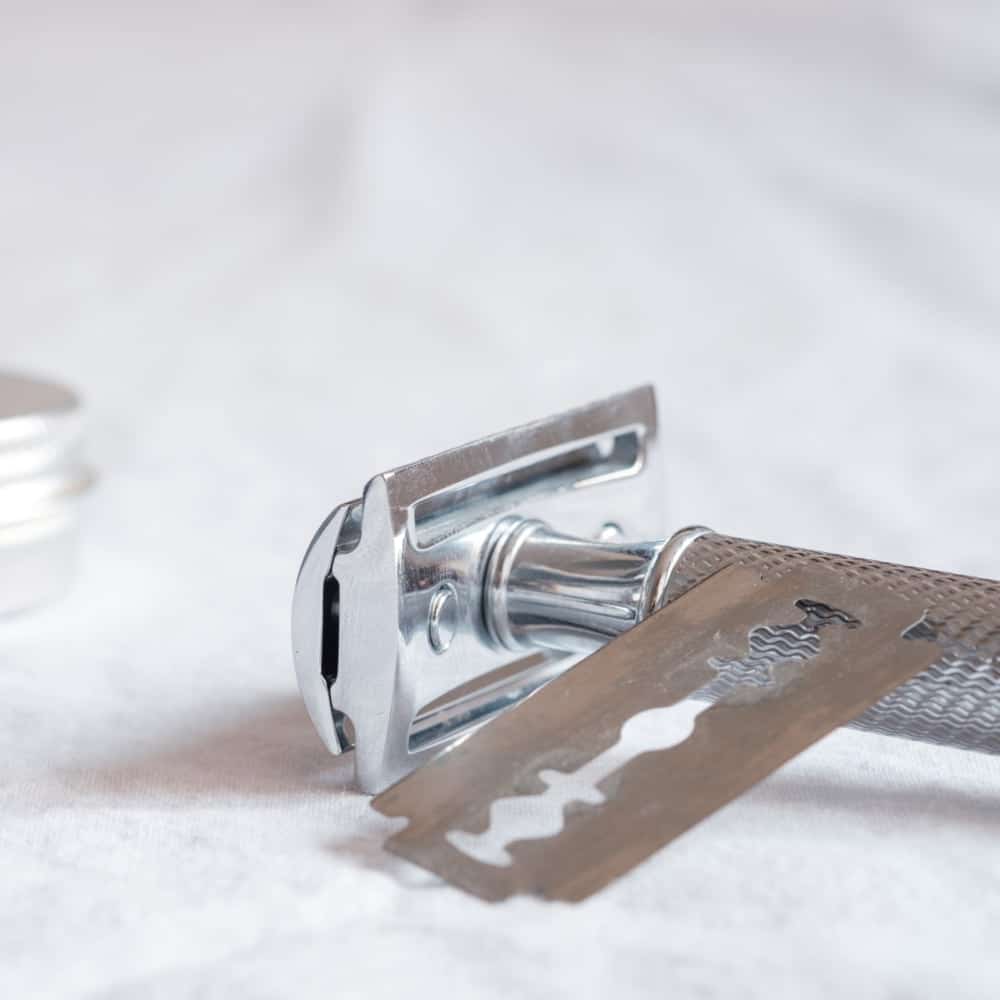Introduced in the early 1900s by King Camp Gillette, safety razors were an evolution of the straight razor. Rather than having a single blade like its predecessor, the safety razor introduced two blades, a safety bar, and with it, a whole new form factor.
This article will go over the components of the safety razor, the key differences among them, and how they impact the shave.
Article Highlights
Here’s some of the key points we cover in this article:
| Safety Razor Feature | What you Need to Know |
|---|---|
| Handle | Varies in grip, texture, and weight; heavier handles can help the blade do the work with minimal pressure applied by the shaver |
| Head | Open comb, closed comb, or slant design; the open comb is more aggressive, while closed comb and slant are milder |
| Pieces | One, two, or three-piece design; one-piece is easier to swap blades, while three-piece is easier to clean |
| Compatible Blades | Any universal blade can be used with any safety razor |
| Shave Experience | Takes patience and practice to master; hold blade at certain angle and shave in the direction of hair growth to reduce irritation |
| Core Benefits | Cost savings, no ingrown hairs, and less waste |
| Notable Drawbacks | Not travel friendly, and limited use outside of face shaving |
Components
Safety razors are made up of two core components:
- Handle
- Head
While this may seem simple, there are a lot of nuances to each of these components that can impact the shave.
Handle

The handle has an outsized impact on the grip and how the razor performs while shaving. Safety razors come in various grips, including a knurled grip, smooth, hexagonal, and more. The more texture to the grip, the less likely it will slip out of your hand, even when coated in shaving cream.
The handle of the safety razor also holds much of the weight. Heavier razors are more likely to give you a better shave as you can simply let the weight of the razor cut the hair for you. With heavier razors, like the MErkur 38C, as the shaver, you just need to guide the razor and not apply any additional pressure.
Head

Safety razor heads will be one of the following: open comb, closed comb, or slant. Here’s how each of these differs:
- Open Comb: This design works well for those with thick hair and who have trouble getting a close shave with other designs. However, due to the increase in blade exposure, the open comb design is significantly more aggressive than a closed comb and slant designs. Open combs have a rake-like design and do not contain a safety bar.
- Closed Comb: The closed comb design is the most common type of safety razor. This design allows for a milder shave. To know whether or not a safety razor has a close combe design, you’ll want to look for a safety bar extending the entire width of the razor’s head.
- Slant: Relegated to niche offerings like the Merkur 37C or the Parker Semi Slant, the slant head cuts the hair at an angle. This is more akin to a scythe and reduces the tug or pull on the root of the hair follicle. Folks with sensitive skin find this design quite helpful.
Pieces
Safety razors will either have a one, two, or three-piece design.
One-piece designs, often referred to as butterfly safety razors, have a cap that opens with a twist of the handle. This design makes it easy to swap out blades but does add some bulk to the head – making it tougher to navigate around the face.
Two and three-piece designs are nearly identical to one another. The only difference is whether the blade mount is removable. There is an argument among those in the wet shaving community that the three-piece design is preferred as there are no welded points, and you can thoroughly clean each piece of the razor more effectively.
Compatible Blades

Safety razors feature a universal blade setting. This allows you to use any brand of the blade with any safety razor. Unlike cartridge razor systems, you aren’t locked into a proprietary system. Furthermore, the price per blade is also significantly lower than other shaving systems. One of the many reasons why safety razors have become so popular in recent years.
There isn’t one ‘best’ blade per se, but instead, it’s best to try a few different blades and see which one works best for your skin and facial hair.
Shave Experience

Whether you are new to shaving or have used a cartridge razor for some years, learning to use a safety razor takes patience. You must hold the blade at a certain angle and apply little to no pressure. Additionally, you’ll want to make sure you shave in the direction of hair growth to reduce irritation.
For the most part, folks can master this tool and shave confidently in a few weeks of persistent practice.
Core Benefits
What folks enjoy most about the safety razor is the following:
- Cost Savings: Costing only pennies per blade, the savings that you attain with a safety razor is unmatched by nearly all other shaving systems except for straight razors.
- No Ingrown Hairs: Men with exceptionally curly or coarse facial hair are more susceptible to ingrown hairs. These painful bumps happen when the hair is cut at a fraction below the skin’s surface. When the hair grows back, it curls into the skin, forming a bump. With only a single cutting edge, the hair is only ever cut to the skin’s surface, never below – drastically reducing the risk of ingrown hairs.
- Less Waste: Unlike cartridge or disposable razors that are made of plastic and eventually find their way into landfills, safety razors are made of metal and can be recycled.
Notable Drawbacks
While the safety razor is a great tool, it does have a few drawbacks:
- Not Travel Friendly: While you can take the safety razor handle on the plane, the double edge razor blades must be checked in your luggage. If this isn’t an option, then buying blades at your destination is the next best option, but due to the lack of popularity, they can be somewhat hard to find.
- Limited Use: Safety razors work well on the face. While you can use them on the chest, back, and legs, they may not be as practical or as safe as, say, a cartridge razor.